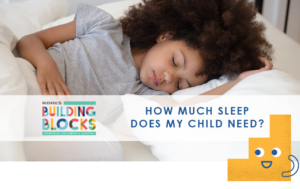
By: Rebecca Michelsen, M.Ed., MCHES, Penfield Children’s Center
As parents, we strive to do everything possible to support our children’s health and development, including making sure our children are getting enough sleep. A child who is well rested is more alert, and has better memory and performance. They are also less prone to experience behavioral problems and moodiness.
So how much sleep should your child be getting? The American Academy of Pediatrics, the American Academy of Sleep Medicine and the National Sleep Foundation have outlined the recommended amount of sleep a child needs within a 24-hour time period, based on their age, in order to be well-rested. When we calculate the amount of time our children spend sleeping, we should take into account any naps they take throughout the day, since that time is included in the total amount of recommended time.
Below is a chart from the National Sleep Foundation that outlines the recommended amount of sleep for children from birth to age 17. An hour or two more or less than the recommended time may be appropriate, as each child’s sleep needs are different. However, it is recommended that children not sleep longer, or less than, a one- to two-hour time difference because that can affect their ability to get restful sleep.
| Age | Recommended | Not recommended |
| Newborns
0 to 3 months |
14 to 17 hours | Less than 11 hours
More than 19 hours |
| Infants
4 to 11 months |
12 to 15 hours | Less than 10 hours
More than 18 hours |
| Toddlers
1 to 2 years |
11 to 14 hours | Less than 9 hours
More than 16 hours |
| Preschoolers
3 to 5 years |
10 to 13 hours | Less than 8 hours
More than 14 hours |
| School-aged Children
6 to 13 years |
9 to 11 hours | Less than 7 hours
More than 12 hours |
| Teenagers
14 to 17 years |
8 to 10 hours | Less than 7 hours
More than 11 hours |
In order to make sure our children are getting enough restful sleep, below are some basic tips for creating and keeping a regular bedtime routine.
- Create a consistent, enjoyable bedtime routine that ends in the room where the child sleeps. A bedtime routine might consist of activities like a light snack, taking a bath or reading a book.
- Make the bedroom environment the same every night and throughout the night. Keep the lighting, temperature and even the sounds the same throughout the night.
- Set a digital curfew. Blue light from electronics, including televisions, can increase alertness. Encourage your child to turn off electronics about one to two hours before bedtime.
If you have any concerns about the amount or quality of sleep that your child is getting, you should talk with your child’s pediatrician. He/she can help determine if there is an underlying sleep disorder or medical condition that is affecting your child’s sleep.
Resources:
- How Much Sleep Do Babies and Kids Need? – National Sleep Foundation https://sleepfoundation.org/excessivesleepiness/content/how-much-sleep-do-babies-and-kids-need
- American Academy of Pediatrics Supports Childhood Sleep Guidelines – American Academy of Pediatrics https://www.aap.org/en-us/about-the-aap/aap-press-room/pages/American-Academy-of-Pediatrics-Supports-Childhood-Sleep-Guidelines.aspx
- How Blue light affects kids and sleep – National Sleep Foundation https://sleepfoundation.org/sleep-topics/how-blue-light-affects-kids-sleep
- Sleep training: Helping your child get to bed and stay asleep – Penfieldbuildingblocks.org http://penfieldbuildingblocks.org/2014/09/sleep-training-helping-child-get-bed-stay-asleep/


Leave a Reply